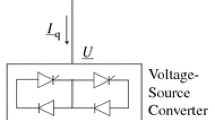Abstract
This paper presents a simple implementation of Static Shunt Compensator (STATCOM) into Newton–Raphson current injection load flow method. The controlled STATCOM bus in the network is represented by voltage-controlled bus with zero active power generation at the required voltage magnitudes. The power mismatch equation of the connected STATCOM bus is included in Newton–Raphson current injection load flow algorithm, while the other PQ buses are represented by current mismatch equations. Moreover, the parameters of STATCOM can be calculated during iterative process and the final value will be updated after the convergence is achieved. This representation of generator buses reduces the number of required equations with respect to the classical and improved versions of the current injection methods. In addition of that the developed model reduces the complexities of the computer program codes and enhances the reusability by avoiding modifications in the Jacobian matrix. The performance of the developed STATCOM model has been tested using standard IEEE systems.





Similar content being viewed by others
Abbreviations
- PV:
-
Voltage controlled buses
- NR:
-
Newton–Raphson method
- PQ:
-
Load buses
- CB:
-
Connected STATCOM bus
- FACTS:
-
Flexible AC transmission systems
- STATCOM:
-
Static synchronous compensator
- SVC:
-
Static VAR compensator
- VSC:
-
Voltage source convertor
- N:
-
Total number of buses
- \(N_{\mathrm{PV}}\) :
-
Total number of voltage controlled nodes
- CM:
-
Current mismatch
- PM:
-
Power mismatch
- ICM:
-
Improved current mismatch load flow method
- HM:
-
Hybrid mismatch load flow method
- GTO:
-
Gate turn-off
- IGBT:
-
Insulated gate bipolar transistors
- IGCT:
-
Integrated gate commutated thyristors
- MCT:
-
Metal-oxide semiconductor controlled thyristor
- \(P, Q\) :
-
Active and reactive complex powers
- \(V\) :
-
Magnitude of node voltage
- \(\delta \) :
-
Angle of node voltage
- \(\Delta \) :
-
Refer to mismatches of variables
- \(I\) :
-
Current injection
- \(h\) :
-
iteration number
- r,m:
-
Subscripts refer to real and imaginary parts
- \(k,f\) :
-
Subscripts refer to nodes
- sp:
-
Superscript refers to specified values
- st:
-
Subscript refer to STATCOM device
- \(Z\) :
-
Refer to impedances of devices
- G,B:
-
Real and imaginary parts of admittance matrix
- \(\partial \) :
-
Refers to partial derivatives
References
Gotham DJ, Heydt GT (1998) Power flow control and power flow studies for systems with FACTS devices. IEEE Trans Power Syst 13:60–66
Kamel S, Abdel-Akher M, Jurado F, Ruiz-Rodríguez FJ (2013) Modeling and analysis of voltage and power control devices in current injections load flow method. Electr Power Compon Syst 41:324–344
Radman G, Raje SR (2007) Power flow model/calculation for power systems with multiple FACTS controllers. Electr Power Syst Res 77:1521–1531
Canizares CA, Pozzi M, Corsi S, Uzunovic E (2003) STATCOM modeling for Voltage and angle stability studies. Int J Electr Power Energy Syst 6:421–422
Yankui Z, Yan Z, Bei W, Jian Z (2006) Power injection model of STATCOM with control and operating limit for power flow and voltage stability analysis. Electr Power Syst Res 76:1003–1010
Kamel S, Abdel-Akher M, Song MK (2012) Analysis and modeling of a unified power flow controller in Newton–Raphson load flow. Adv Sci Lett 8:884–889
Bhowmick S, Das B, Kumar N (2011) An advanced static synchronous compensator model to reuse Newton and decoupled power flow codes. Electr Power Compon Syst 39:1647–1666
da Cost VM, Martins N, Pereira JLR (1999) Developments in the Newton–Raphson power flow formulation based on current injections. IEEE Trans Power Syst 14:1320–1326
da Cost VM, Martins N, Pereira JLR (2001) An augmented Newton–Raphson power flow formulation based on current injections. Electr Power Energy Syst 23:305–312
Garcia PAN, Pereira JLR, Carneiro S, da Cost VM, Martins N (2000) Three-phase power flow calculations using the current injection method. IEEE Trans Power Syst 15:508–514
Garcia PAN, Pereira JLR, Carneiro S, Vinagre MP, Gomes FV (2004) Improvements in the representation of PV buses on three-phase distribution power flow. IEEE Trans Power Deliv 19:894–896
Gyugyi L (1994) Dynamic compensation of AC transmission lines by solid-state synchronous voltage source. IEEE Trans Power Deliv 9:904–911
Prenesh R, Crow ML, Yang Z (2000) STATCOM control for power system voltage control applications. IEEE Trans Power Deliv 15:1311–1317
Zhiping Y, Crow ML, Chen S, Lingli Z (2000) The steady-state characteristics of a STATCOM with energy storage. Power Eng Soc Summer Meet 2:669–674
Kamel S, Abdel-Akher M, Jurado F (2013) Improved NR current injection load flow using power mismatch representation of PV Bus. Int J Electr Power Energy Syst. doi:10.1016/j.ijepes.2013.03.039
Acha E, Fuerte-Esquivel CR, Ambriz-Perez H (2004) FACTS modeling and simulation in power networks. Wiley, England
Acknowledgments
The authors gratefully acknowledge the contribution of the Spanish Ministry of Foreign Affairs and Cooperation (MAEC) and the Spanish Agency for International Cooperation (AECI), for providing research funding to the work reported in this research.
Author information
Authors and Affiliations
Corresponding author
Appendix
Appendix
The parameters \((a_{f},\; b_{f},\; c_{f}\) and \(d_{f})\) in Eq. (1) can be given as following:
where
When the bus has only a constant power load, the parameters are simplified to
These parameters are updated during the iterative load flow process.
Rights and permissions
About this article
Cite this article
Kamel, S., Jurado, F. & Vera, D. A simple implementation of power mismatch STATCOM model into current injection Newton–Raphson power-flow method. Electr Eng 96, 135–144 (2014). https://doi.org/10.1007/s00202-013-0288-4
Received:
Accepted:
Published:
Issue Date:
DOI: https://doi.org/10.1007/s00202-013-0288-4




